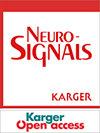ß-Klotho上调兴奋性氨基酸转运蛋白EAAT1和EAAT2
Q1 Medicine
引用次数: 13
摘要
背景/目的:Klotho是一种在脑、肾和其他组织的绒毛膜丛中表达的跨膜蛋白,是FGF23抑制1,25(OH)2D3形成所必需的。Klotho蛋白的胞外结构域可以被剥离,从而释放到血液或脑脊液中。通过发挥β-葡萄糖醛酸酶的活性,可溶性克洛索至少在一定程度上调节了几种离子通道和载体。Klotho蛋白缺乏会加速年龄相关疾病的出现,包括神经变性和肌肉萎缩,最终导致过早死亡。本研究探讨Klotho蛋白对兴奋性谷氨酸转运体EAAT1 (SLC1A3)和EAAT2 (SLC1A2)的影响,这些Na+偶联载体清除突触间隙中的兴奋性氨基酸,从而参与神经元兴奋性的调节。方法:将编码EAAT1或EAAT2的cRNA注射到非洲爪蟾卵母细胞中,以谷氨酸(2 mM)诱导内向电流(IGlu)作为谷氨酸转运的指标。在没有和存在β-葡萄糖醛酸酶抑制剂d -糖酸1,4-内酯一水合物(DSAL,10µM)的情况下,用可溶性ß-Klotho蛋白(30 ng/ml)处理24 h或事先不进行测量。结果:在表达EAAT1和EAAT2的卵母细胞中可见IGlu,而在注射水的卵母细胞中未见IGlu。在这两种情况下,表达EAAT1和EAAT2的卵母细胞IGlu均通过可溶性ß-Klotho蛋白处理而显著升高,这一作用被DSAL逆转。ß-klotho蛋白处理显著提高了最大转运率,但未显著改变载体的亲和力。结论:ß-Klotho上调兴奋性谷氨酸转运体EAAT1和EAAT2,参与神经元兴奋调节。本文章由计算机程序翻译,如有差异,请以英文原文为准。
Up-Regulation of Excitatory Amino Acid Transporters EAAT1 and EAAT2 by ß-Klotho
Background/Aims: Klotho, a transmembrane protein expressed in chorioid plexus of the brain, kidney, and several other tissues, is required for inhibition of 1,25(OH)2D3 formation by FGF23. The extracellular domain of Klotho protein could be cleaved off, thus being released into blood or cerebrospinal fluid. At least in part by exerting β-glucuronidase activity, soluble klotho regulates several ion channels and carriers. Klotho protein deficiency accelerates the appearance of age related disorders including neurodegeneration and muscle wasting and eventually leads to premature death. The present study explored the effect of Klotho protein on the excitatory glutamate transporters EAAT1 (SLC1A3) and EAAT2 (SLC1A2), Na+ coupled carriers clearing excitatory amino acids from the synaptic cleft and thus participating in the regulation of neuronal excitability. Methods: cRNA encoding EAAT1 or EAAT2 was injected into Xenopus laevis oocytes and glutamate (2 mM)-induced inward current (IGlu) taken as measure of glutamate transport. Measurements were made without or with prior 24 h treatment with soluble ß-Klotho protein (30 ng/ml) in the absence and presence of β-glucuronidase inhibitor D-saccharic acid 1,4-lactone monohydrate (DSAL,10 µM). Results: IGlu was observed in EAAT1 and in EAAT2 expressing oocytes but not in water injected oocytes. In both, EAAT1 and EAAT2 expressing oocytes IGlu was significantly increased by treatment with soluble ß-Klotho protein, an effect reversed by DSAL. Treatment with ß-klotho protein increased significantly the maximal transport rate without significantly modifying the affinity of the carriers. Conclusion: ß-Klotho up-regulates the excitatory glutamate transporters EAAT1 and EAAT2 and thus participates in the regulation of neuronal excitation.
求助全文
通过发布文献求助,成功后即可免费获取论文全文。
去求助
来源期刊

Neurosignals
医学-神经科学
CiteScore
3.40
自引率
0.00%
发文量
3
审稿时长
>12 weeks
期刊介绍:
Neurosignals is an international journal dedicated to publishing original articles and reviews in the field of neuronal communication. Novel findings related to signaling molecules, channels and transporters, pathways and networks that are associated with development and function of the nervous system are welcome. The scope of the journal includes genetics, molecular biology, bioinformatics, (patho)physiology, (patho)biochemistry, pharmacology & toxicology, imaging and clinical neurology & psychiatry. Reported observations should significantly advance our understanding of neuronal signaling in health & disease and be presented in a format applicable to an interdisciplinary readership.
 求助内容:
求助内容: 应助结果提醒方式:
应助结果提醒方式:


